

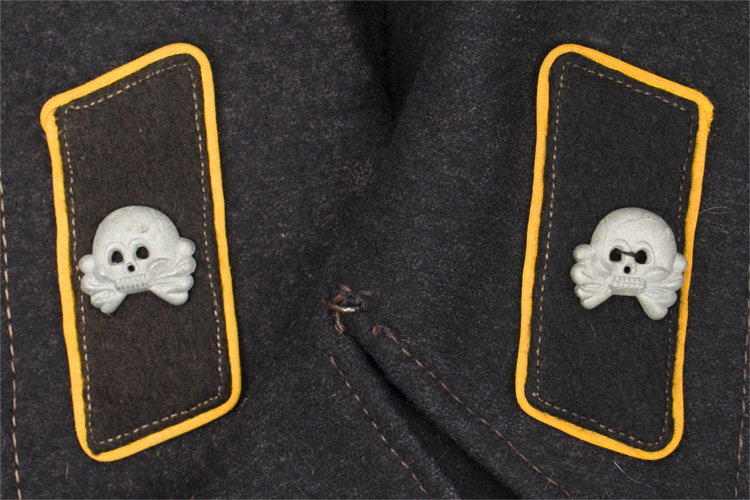
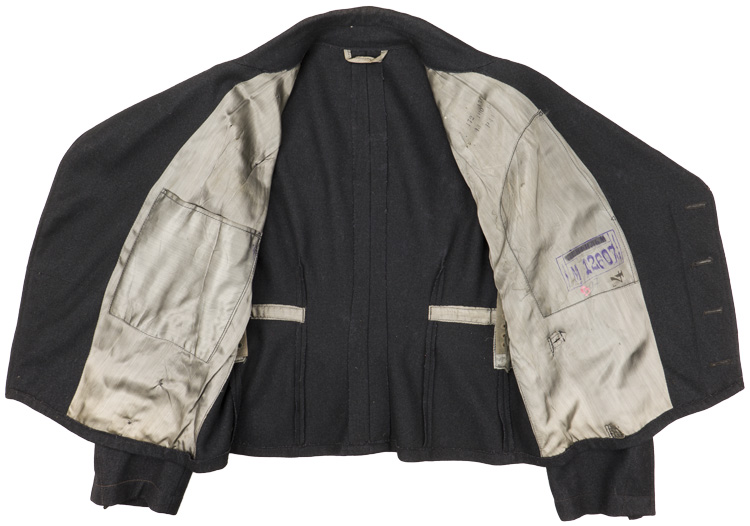
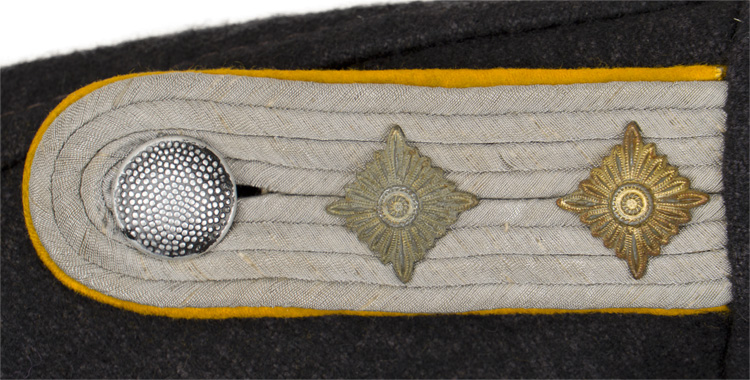
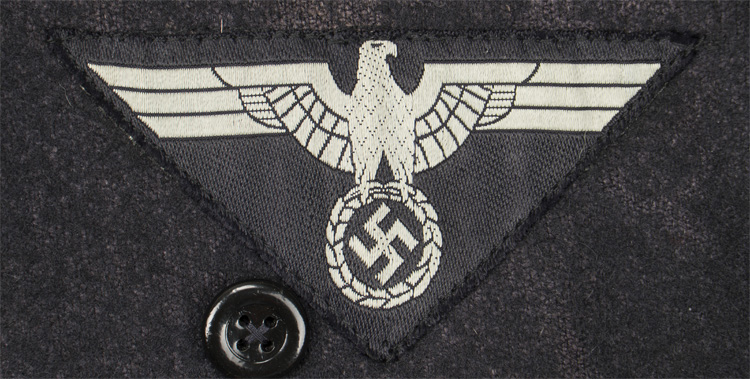
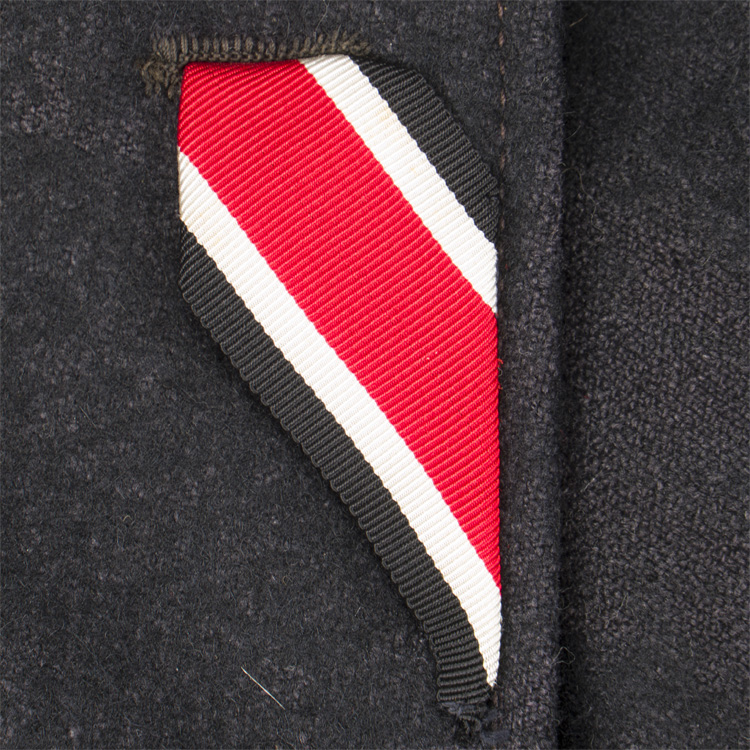
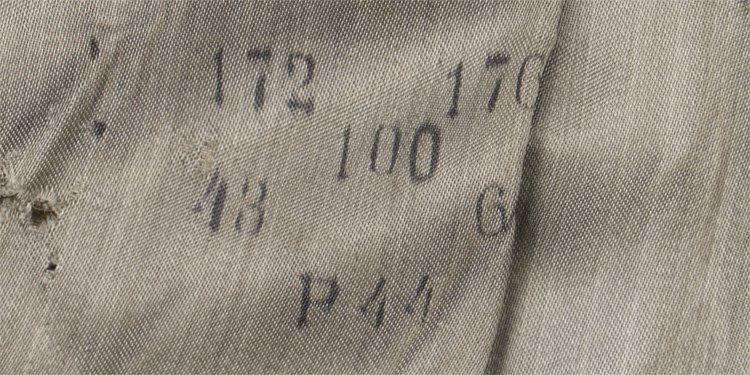

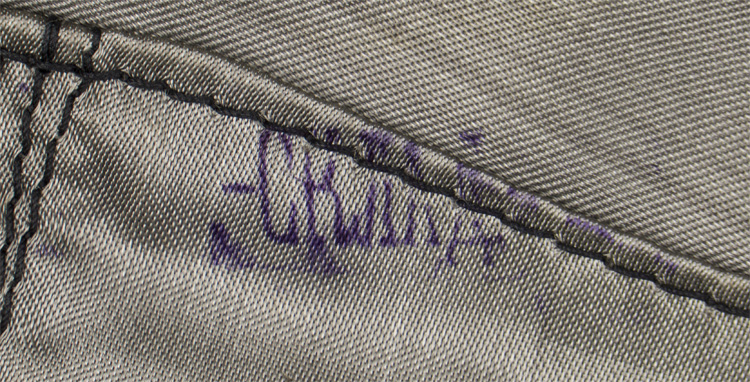

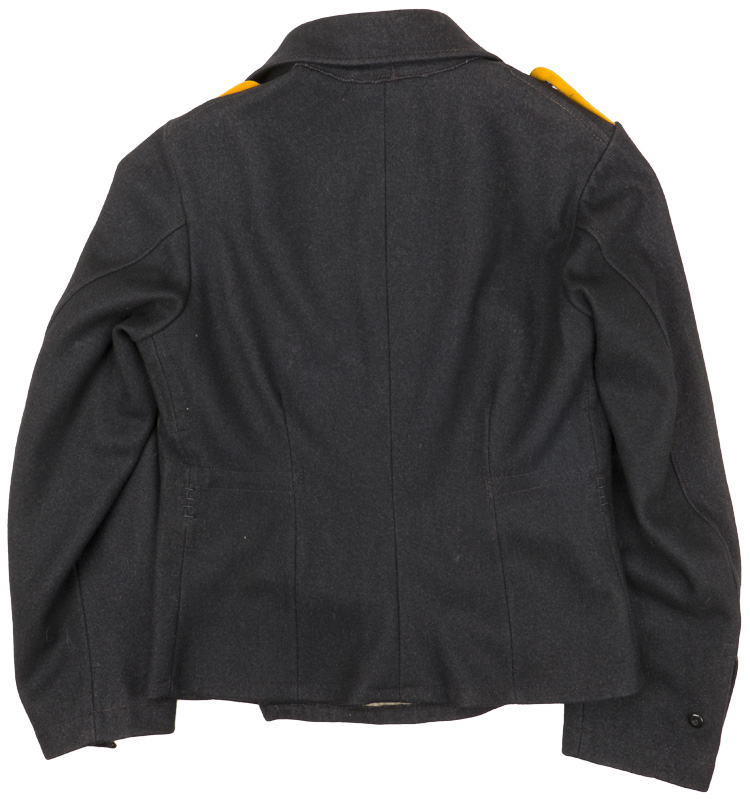
H000892 ARMORED RECONNAISSANCE OFFICER’S BLACK PANZER WRAP TUNIC. (Feldjacke)
BACKGROUND: The black Panzer Wrap tunic was originally introduced by the army on November 12TH 1934, for wear by armored vehicle personnel and was worn through-out the war with minor modifications in 1936 and 1942. Allegedly Chief of the motorized troops, Oberst Heinz Guderian came up with the coloration and design of the form fitting uniform which he based on a popular ski outfit of the time. Black was chosen as the color as it help conceal the grease and grime commonly encountered by motorized personnel. Officers and certain senior NCO ranks were responsible for purchasing their own uniforms and as a result were allotted a clothing allowance through the army’s Kleiderkasse, (Clothing Account), system. The Officers and certain senior NCO’s could choose to purchase their uniforms from the armed forces clothing depots or to privately purchase garments of higher quality. Although enlisted personnel were issued their uniforms from government supplies they were also permitted to purchase privately tailored uniforms although the price may have been restrictive. The different branches of service within the army were allocated a particular identifying waffenfarbe, (Branch of Service Color), with pink being chosen for Panzer, (Armored), personnel. Of Note: The general waffenfarbe for all armored units was pink although other colors were utilized including red for armored artillery units, golden yellow for armored reconnaissance units and the 24TH Panzer Division, lemon yellow for armored signals units and, for a short time, alternating black and white for armored engineer units. On the field blouse, service tunic and Panzer wrap tunic the waffenfarbe was generally displayed on the shoulder straps/boards and the collar tabs. Originally the Panzer wrap tunics also utilized the waffenfarbe as piping on the forward edge of the collar until regulations of mid-1942 abolished the use of the collar piping and instructed it to be removed from the tunics, although the directive was not strictly adhered to. Also Of Note: The waffenfarbe color for armored reconnaissance units was changed no less then three times during the course of the war with pink, golden yellow, copper brown all being utilized at different times. In commemoration of their origin, personnel serving in armored reconnaissance units used cavalry terminology to distinguish their ranks.
PHYSICAL DESCRIPTION: Nice quality, second pattern, (circa 1936-1945), black wool/rayon blend construction, waist length, double breasted style tunic with small fold back lapels and a large lay down collar. The left front closure panel of the tunic has three hidden button holes and an additional three, visible button holes on the fold back lapel. The right front closure panel has all three large and three smaller corresponding buttons intact. The edge of the right front closure panel has an additional, two, small, buttons positioned underneath the overlapping left closure panel with two, corresponding, internal, fabric loops for a secure closure with a neat appearance. The tunic also has a single metal hook and eye positioned at the forward neckline for a secure closure. The right breast has an M44 pattern, machine woven, national eagle in matte grey threads on a cut-out, woven black rayon base. The eagle is neatly machine stitched to the tunic. Award loops for one breast badge and a EK2 ribbon. The tunic has no exterior pockets. The reverse of the tunic has a central, vertical, seam and two, vertical, tapering darts. The waistline side seams of the tunic each have four, vertically aligned, horizontal, rows of heavy stitching with a central vertical slash to secure the belt support hooks. The belt support hooks are absent. The straight cut sleeve cuffs each have a vertical outside seam slash with dual, fit adjustment buttons. Sew on should boards for the rank of Hauptmann. The tunic has a large lay down collar with the typical zig-zag reinforcement stitching to the reverse. The collar has no waffenfarbe piping as per regulations of mid-1942. The collar features the elongated, black wool collar tabs with the typical, silver washed, stamped alloy, Danziger style Totenkopf cyphers (one is sewn on through the eye sockets) and golden yellow rayon waffenfarbe piping to the outside edges. The interior breast panels are lined in grey rayon. The lining has a horizontal slash, patch pocket to the right breast panel and a vertical slash patch pocket to the left breast panel. The interior of the tunic also has two, vertical, grey rayon straps with four stitched eyelets to each, situated at the waistline side seams to secure the belt support hooks. The interior also has a horizontal, tunnel looped, grey rayon, fit adjustment drawstring to each of the waistline side panels. Excellent size markings with a 1944 depot date. Russian Museum marking. All of the insignia should be considered restored on this example. The shoulder board retaining buttons are the pebbled, alloy type while the balance of the buttons are the molded black bakelite type and all appear to have their original stitching. The tunic is roughly size 36" chest. Nice example.
GRADE **** PRICE $3,995.00
To Order this item, please use one of the two e-mail addresses below to contact us. Please make sure to quote the item number in your e-mail
MILITARIA WANTED! If you have items for sale, please contact us. We specialize in selling single pieces and entire collections. Over 3 decades in the business and we do all the work for you. Get the best return for your investment.
-E-Mail Address pawmac@nbnet.nb.ca Or guild@nb.aibn.com
To return to the main page please CLICK below